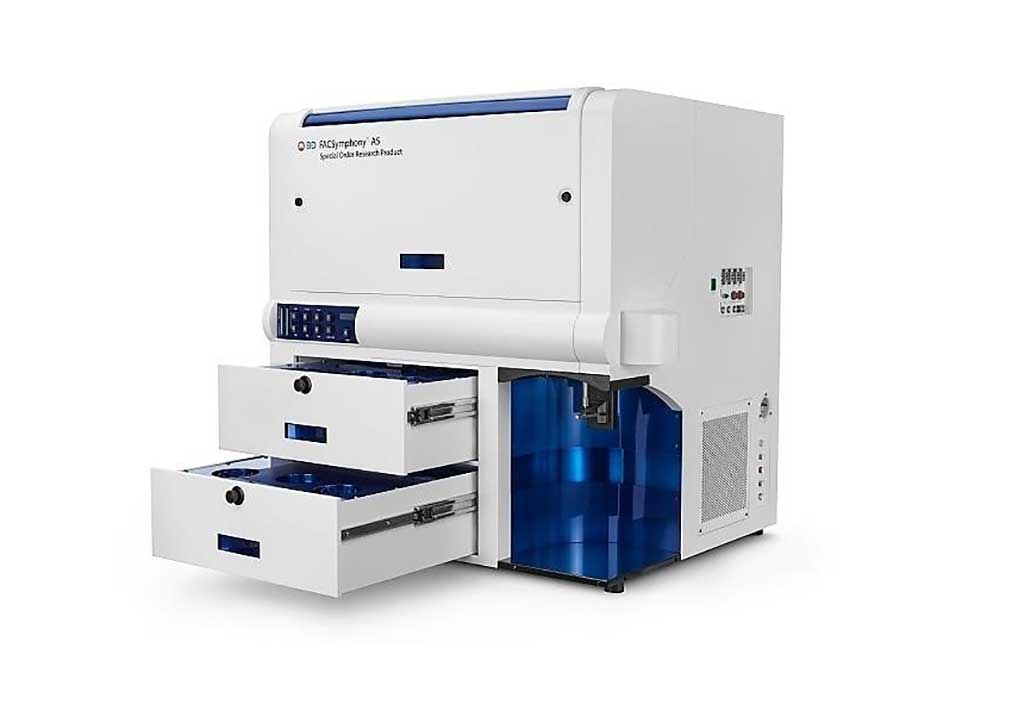MAIT Cell Activation Dynamics Associated with COVID-19 Disease Severity
By LabMedica International staff writers
Posted on 13 Oct 2020
The balance between protective versus pathological immune responses in COVID-19 has been a concern since the onset of the pandemic. SARS-CoV-2 infection can lead to acute respiratory distress syndrome (ARDS), a condition characterized by aggressive inflammatory responses in the lower airways.Posted on 13 Oct 2020
Severe COVID-19 is not only due to direct effects of the virus, but also in part to a misdirected host response with complex immune dysregulation of both innate and adaptive immune and inflammatory components. Emerging evidence indicates that mucosa-associated invariant T (MAIT) cells are innate-like sensors of viral infection.

Image: The BD FACSymphony A5 flow cytometer (Photo courtesy of BD Biosciences).
Infectious Disease specialists at the Karolinska University Hospital (Stockholm, Sweden) recruited 69 SARS-CoV-2-infected patients 18 to 78 years old with acute COVID-19 disease admitted to the hospital, or followed up in convalescent phase. The team examined blood samples from 24 patients admitted to the Karolinska University Hospital with COVID-19 disease and compared them to blood samples from 14 healthy controls and 45 individuals who had recovered from COVID-19.
Absolute counts in whole blood were assessed by flow cytometry using BD Multitest 6-color TBNK reagents in association with BD Trucount tubes (BD Biosciences, San Jose, CA, USA). Sera were evaluated for soluble factors using proximity extension assay technology (Olink AB, Uppsala, Sweden). Flow cytometry was performed using multiple antibodies and Samples were acquired on a BD Biosciences’ BD FACSymphony A5 flow cytometer.
The investigators found that the number of circulating MAIT cells was sharply lower in COVID-19 patients and the remaining MAIT cells were highly activated, indicating that they play a role in the response to SARS-CoV-2. Further, single-cell RNA sequencing data suggests that MAIT cells are highly enriched among T cells infiltrating in the airways of COVID-19 patients.
Flow cytometry phenotypes of MAIT cells in COVID-19 found that they were characterized by high expression of CD69 (CD69high) and diminished expression of the chemokine CXCR3 (CXCR3low). Both phenotypes were associated with poor clinical outcomes in the patient cohort. Within the airways, transcriptomic analysis revealed significant MAIT cell enrichment and proinflammatory interleukin 17A (IL-17A) profile.
In convalescent patients, there seems to be a recovery of MAIT cells, including normalization of phenotypes, within weeks from resolution of symptoms. The authors suggested that this may help patients fight future microbial infections. Interestingly, CXCR3 levels were still low in some convalescent samples, raising the possibility that it may be a lasting alteration in MAIT cells post-COVID-19.
Johan K. Sandberg, PhD, a Professor of Medicine and senior author of the study, said, “The findings of our study show that the MAIT cells are highly engaged in the immunological response against COVID-19. A likely interpretation is that the characteristics of MAIT cells make them engaged early on in both the systemic immune response and in the local immune response in the airways to which they are recruited from the blood by inflammatory signals. There, they are likely to contribute to the fast, innate immune response against the virus. In some people with COVID-19, the activation of MAIT cells becomes excessive and this correlates with severe disease.” The study was published on September 28, 2020 in the journal Science Immunology.
Related Links:
Karolinska University Hospital
BD Biosciences
Olink AB














